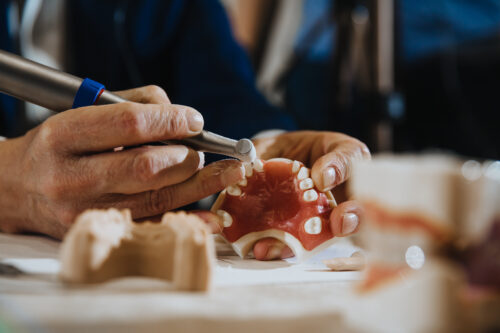
If you’re missing one or more teeth, a dental bridge will often be the treatment a dentist suggests to replace them. While the process of getting a bridge installed can be complex, many benefits come with using a dental bridge to replace missing teeth. They can restore chewing function and speech, enhance appearance, and improve oral health. Please continue reading to learn when dental bridges are necessary and how our experienced dental bridges/dentists located in Basking Ridge & Morristown, NJ, can help you determine whether a dental bridge is the proper treatment for your needs.
When is a Dental Bridge Recommended?
A dental bridge replaces one or more missing teeth in a row. As its name suggests, this appliance literally “bridges” the gap in your smile by anchoring onto each adjacent tooth on the sides of the gap. The bridge placement procedure usually requires at least two dental visits. This makes it a highly convenient tooth replacement choice, as patients who replace their teeth with dental implants would need at least two months to achieve a fully functioning smile. Two parts make up a dental bridge: abutments and pontics. Abutments are the structure that supports your bridge. Pontics are the false teeth that fill the gap left behind by missing teeth.
A bridge is often necessary when a patient suffers tooth decay, resulting in their teeth falling out or needing to be extracted, or if damage to a tooth is beyond repair. It’s recommended when a patient cannot undergo major dental procedures due to certain health conditions like cancer or diabetes. In addition, when a patient has strong teeth near the gaps, they are good candidates for bridges because the nearby teeth need to be strong enough to provide adequate support.
What Are the Different Types of Bridges?
Depending on your oral health goals, dentists may use one of three different types of dental bridges. A traditional dental bridge is the most common type of dental bridge that consists of dental crowns on both ends that are bonded to your natural teeth, and pontics fill in the space between. This option is usually reserved for healthy teeth on both sides of the gap.
Another option your dentist may recommend is a Cantilever dental bridge, similar to a traditional bridge. However, there’s only one crown on one end rather than both. When the dentist bonds the bridge onto your abutment tooth, the pontic will extend across the gap to fill the space in between. This option is usually reserved for those who don’t have teeth on either side of the missing tooth. Furthermore, a dentist may suggest a Maryland dental bridge. This type of bridge is resin-bonded, which uses metal wings instead of crowns to secure placement. Essentially, your neighboring teeth are bonded to the metal wings to secure your bridge in place.
If you have more or more missing teeth, please don’t hesitate to schedule an appointment with our adept dentists, who can walk you through your options for filling in the spaces. At Dental Associates of Basking Ridge, we are prepared to help you find the proper treatment to restore your smile.






